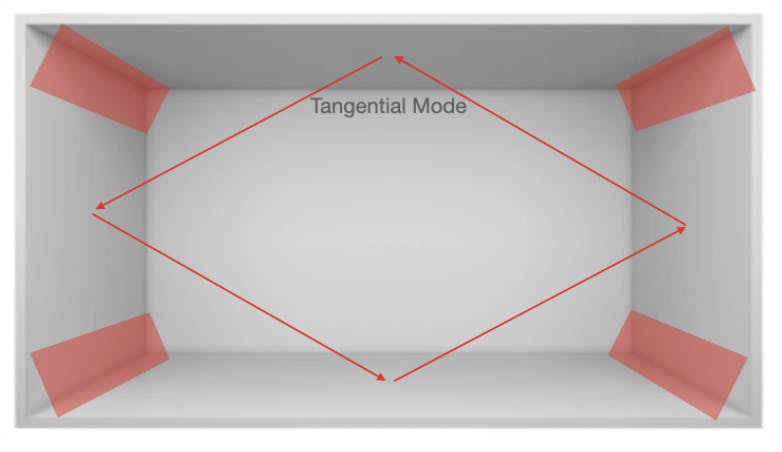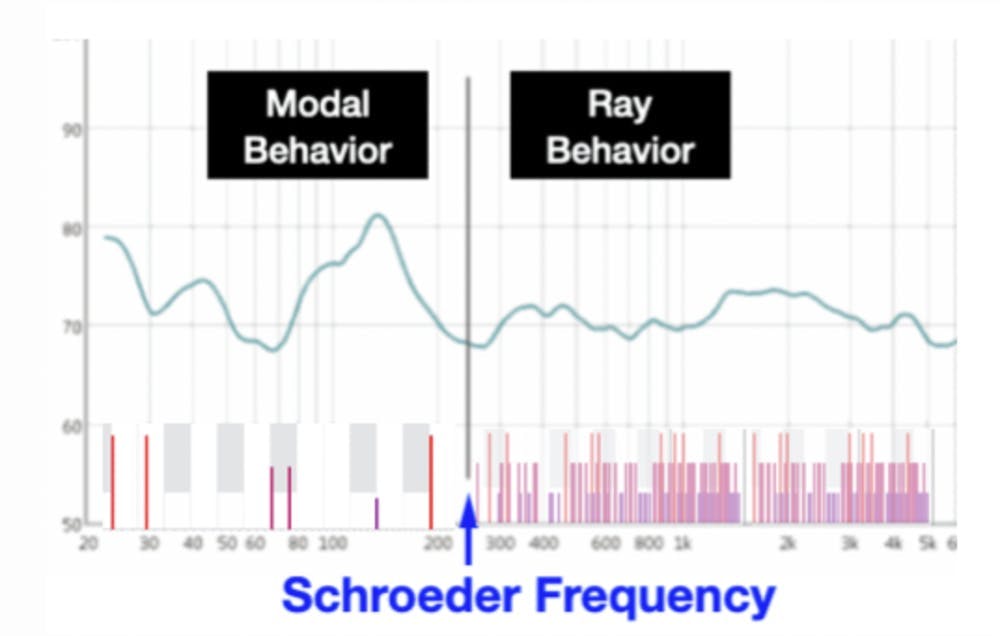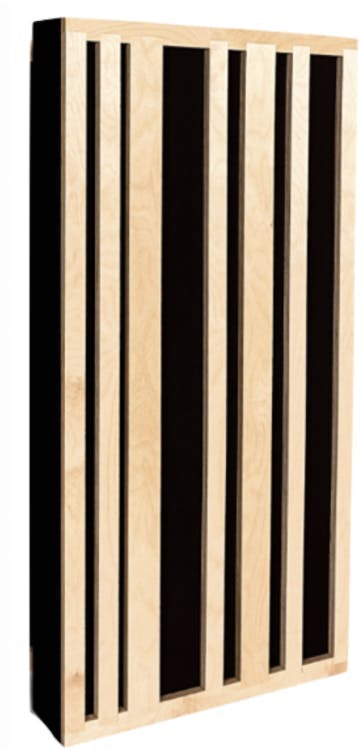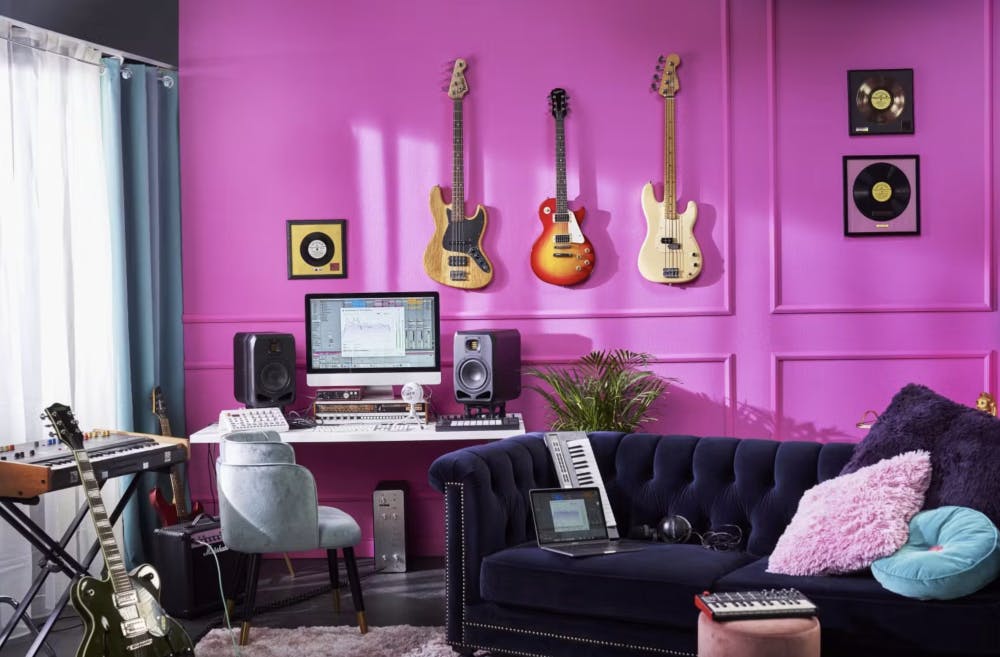In this article, we’ll explore room modes, how they negatively affect your work, and how to fix them.
Allons-y!
Before we get into room modes, let’s define a few things.
What are sound waves?
When an object emits a sound, it disturbs the air molecules around it, causing them to vibrate. These vibrations create pressure waves that we perceive as sound. These waves are characterized by their frequency, wavelength, and amplitude.
- Frequency refers to the number of vibrations or cycles that occur in a second. Frequency is measured in Hertz (Hz).
- Wavelength is the distance of a waveform before it repeats, or the distance between two consecutive points in the wave that are the same phase. Wavelength is related to frequency by the speed of sound, which is approximately 343 meters per second (1,125 ft/s) at 20 °C (68 °F). A 100 Hz waveform is 3.43 meters long (11.25 feet).
- Amplitude is the magnitude of the vibrations, perceived as the loudness of the sound.

What are room modes?
Room modes are acoustic resonances that develop in a room. In an enclosed space (a room), sound waves reflect off boundaries — the walls, the floor, and the ceiling. Reflected sound creates areas of low and high acoustic pressure throughout the room in 3D space. High and low-pressure zones differ for each frequency, so different frequencies will have different apparent loudness in different areas of the room. Many people refer to room modes casually as standing waves. Room modes are a function of the room’s dimensions, length, width, and height; and they occur at any frequency whose half-wavelength (or multiple of that) is equal to any of the dimensions of your room.
In residential-sized rooms, low-frequency modes are spaced widely apart, causing an uneven bass response throughout the room. At frequencies above 250 Hz, the modes become more closely packed together, and their audible effects more or less even out, making them less noticeable.
Try This: You can experience room modes by playing a low-frequency tone like 50 or 60 Hz from your speakers and walking around your room. Near the walls, the tone will sound very loud (high pressure), while in some areas, you may barely be able to hear the tone. The volume of a specific frequency may go up and down like a rollercoaster as you walk across the room. You have now experienced walking through pressure zones created by standing waves.
The first way to minimize the effect of room modes is to locate your listening position where the pressures created by various frequencies are most even and the room modes are least pronounced. There are only one or two best listening positions in any room, usually about 38% of the distance between the front and back wall. You can find information about creating a proper monitor setup in my other article. The next step is to acoustically treat the room to minimize the effects of room modes, so let’s examine the types of room modes.
Types of room modes
There are three types of modes in a rectangular room: axial, tangential, and oblique.
AXIAL modes
These are made up of waves reflecting between two opposite and parallel boundaries, like between the front and back wall, the floor and the ceiling, or the two side walls. Axial modes are the strongest modes and significantly impact the way low frequencies sound in a room.

TANGENTIAL modes
These involve sound waves that reflect from four boundaries, like all four walls, or two opposite walls and the ceiling and the floor. These modes involve two dimensions of the room: length and width, length and height, or width and height. Despite tangential modes having only around half the strength of axial modes, their effect on room acoustics can be significant.

OBLIQUE modes
This category of room modes involves all six surfaces: all four walls, the ceiling, and the floor. These modes have a quarter of the Axial modes’ strength and half of the Tangential modes’ strength.

Find your lowest room mode
The lowest frequency axial room mode is caused by the longest room dimension and can easily be calculated. Divide the speed of sound (343m/s) by 2 times the length (L) in meters.

To find the next two lowest modes, use the same formula with the width and then the height measurements of the room instead of the length. This formula applies to rectangular rooms with the assumption that the walls are rigid and most of the sound is contained. These frequencies are predictions, and in a real room with doors, windows, and various construction materials, your modes may have slightly different frequency centers.
Fret not young padawan, you don’t have to calculate the modes by hand! There are many online room mode calculators, such as this one from amcoustics.com. This calculator will automatically display the axial, tangential, and oblique modes after you enter your room dimensions in feet or centimeters.

Why room modes matter
Room modes create severe dips and boosts in the low-frequency response of your room. This problem can’t be fixed with room EQ or changing your speakers. Untreated room modes make it difficult to balance low frequencies in your mix. When playing bass notes, you may even notice that certain notes disappear or sound much louder than other notes. Room modes can be difficult to treat, but without spending a little time and money to treat your space, your work will suffer.
Acoustic Treatment
In a control room or listening room, our goal is to have short and even decay times at all frequencies, and broadband absorbers are the most practical acoustic treatment for this purpose. Broadband absorbers, like fabric-covered fiberglass or mineral wool, can help reduce the effects of standing waves and eliminate the other problem of first reflections. These absorbers are referred to as velocity absorbers, as the fiberglass material dissipates the velocity of sound waves.
Beware: A common attempt at lowering a room’s decay time is thin foam or fiberglass mounted on the walls. This treatment will only influence frequencies above 1000Hz, creating a room with short decay times at high frequencies, but uncontrolled decay times at mid and low frequencies. This creates a confusing room to work in, as low-frequency issues are the number one problem in small control rooms. Similarly, so-called bass traps that are only a few inches thick will not effectively treat low frequencies below 200 Hz.
Broadband absorber panels of this type should ideally be a minimum of 100 mm (4 inches) thick and up to 200 mm (8 inches). 100 mm-thick panels will absorb frequencies from about 200 Hz and up, while 200 mm panels will extend down to about 100 Hz. Panels typically measure 122 cm (48 inches) x 61 cm (24 inches).
Your room will likely have bass problems below 100 Hz, even as low as 30 Hz. Low-frequency absorption can be enhanced if panels straddle a corner and reach from the floor to the ceiling or straddle the corner between a wall and ceiling. This position increases the airspace behind the panel and lowers its bass absorption down to about 70 Hz. Low frequency can also be treated with another type of absorber called pressure absorbers, which are tuned to very low bass frequencies. We will discuss those later in this article.
Broadband acoustic panels can be mounted directly on the walls or ceiling, but leaving an airspace behind the panel equal to the thickness of the panel will increase their low-frequency absorption. In critical listening environments, covering at least 50% of the wall and ceiling surface of the room with absorbers is where you’ll start hearing an improvement. This requires about 15 to 20 panels for a room that measures 4.5m long x 3.6m wide (15 ft x 12 ft).
Ceiling clouds
One way to greatly reduce floor-to-ceiling room modes is to install ceiling clouds. As a bonus, ceiling clouds above the mix position will remove the first reflections from the ceiling and prevent flutter echo between the floor and ceiling. Ceiling clouds should stretch from over the listening position to above your monitors. Build/buy ceiling clouds that have a core that’s at least 10cm (4”) thick, but if you have the ceiling height, go for 20cm (8”) thick clouds. Hang the clouds 10cm – 20cm (4” to 8”) from the ceiling to extend their low-frequency performance.
Can a Room Have Too Much Bass Trapping?
Do not fear that using a lot of bass trapping means you will hear too little bass in the room. You want to hear the speakers, not the room, and trapping creates a more even and accurate bass response, without ringing and resonances. If your room begins to feel too dead, you can add some high-frequency reflectors, like thin wood slats, over your broadband traps to allow the high frequencies to reflect a bit.

Tuned Pressure Absorbers
The fiberglass panels we’ve been discussing are called velocity absorbers because they absorb the movement or velocity of sound waves. These are inexpensive, easy to mount, portable, and easy to DIY. These panels absorb midrange and high-frequency energy and some low-frequencies, but even with 20 cm (8”) fiberglass panels, their low-frequency absorption will only reach down to about 100 Hz. Bass problems exist well below 100 Hz, likely down to about 30 Hz, so we need some additional help.
Pressure absorbers, also known as Helmholtz resonators, are specially tuned to effectively absorb a narrow range of low frequencies. These devices can be bought or built to fix the bass frequency problems that remain after you have treated your room using as much broadband velocity treatment as is practical. Pressure traps should be considered only after adequate broadband absorption has been applied.
Pressure absorbers only work for a narrow range of frequencies, and they are designed to absorb specific frequencies. For instance, a 70 Hz trap will absorb between about 55 Hz and 100 Hz, but not much else. So, if you have one problem at 40 Hz and one at 70 Hz, you will need traps tuned for each frequency.
Types of pressure traps
Tuned bass traps are referred to as panel absorbers, perforated panel absorbers, slat absorbers, or membrane absorbers. The good news is that a panel absorber only 10 cm (4 inches) deep can treat frequencies as low as 40 Hz. These absorbers must be placed against the wall or ceiling where a problem frequency has its greatest pressure. While these panels are costly to buy, they are relatively simple to DIY, and information can be found online.
In addition to pressure these passive absorbers, active bass traps are available from PSI, Bag End, and other companies. These active absorbers automatically detect and help eliminate modal problems, but they are extremely costly compared to other solutions.
Software room correction systems
It’s important to note that room correction software and hardware do not replace acoustic treatment. Software like SoundID Reference and other room correction devices will optimize and noticeably improve your speaker’s performance, but they can’t overcome room modes and first reflection problems that can only be treated with acoustic treatment and proper room setup. Treat with acoustics first and software second!
DIY BROADBAND ABSORBERS
There are plenty of online resources that go in-depth on building DIY broadband absorbers, so I’ll only cover a few key aspects.
- Rockwool is a very popular choice for acoustic treatment as it has excellent sound-absorbing properties. Roxul and Knauf are common brands.
- Rigid fiberglass can also be used. Owens Corning 703 is commonly used.
- You can buy rockwool and fiberglass in various densities and thicknesses. Thicker panels should use less dense insulation.
- It is recommended to use 10cm (4 inches) thick panels, but if your room allows for it, go for 20cm (8”) thick panels. In the USA, home improvement stores typically sell 9cm (3.5”) thick Roxul panels (Safe n Sound) that can be doubled up to create 18cm (7”) thick panels.
- DIY panels are easily made with fabric-covered wood frames. Create 61 cm X 122 cm frames with the depth to match the insulation used.
- For the fabric panels, you can use burlap, cotton, or polyester. Any fabric that you can cover your mouth and breathe through will work.
Determining Your Room’s Actual Modes
As discussed, you can predict the room modes by using the room’s dimensions, but these predicted modes will differ slightly from real-world problems. Pressure traps have a narrow range of effectiveness, so we need to know the specific modes that exist in our room. Fortunately, there are two easy and free ways to determine the lowest modal problems. Both of these solutions involve the free Room EQ Wizard software acoustic measurement software.
- The first way is a structured listening test, where you play a low-frequency sweep tone from 20 Hz up to 150 Hz and listen for which frequencies sound the loudest and softest. A sweep tone generator is part of Room EQ Wizard.
- The second method involves measuring the acoustic performance of your room using Room EQ Wizard and an inexpensive measurement microphone. There are many online tutorials on how to use Room EQ Wizard.
Continue reading our other blog posts about setting up your speakers the right way and find out whether you should place the speakers against the wall.



